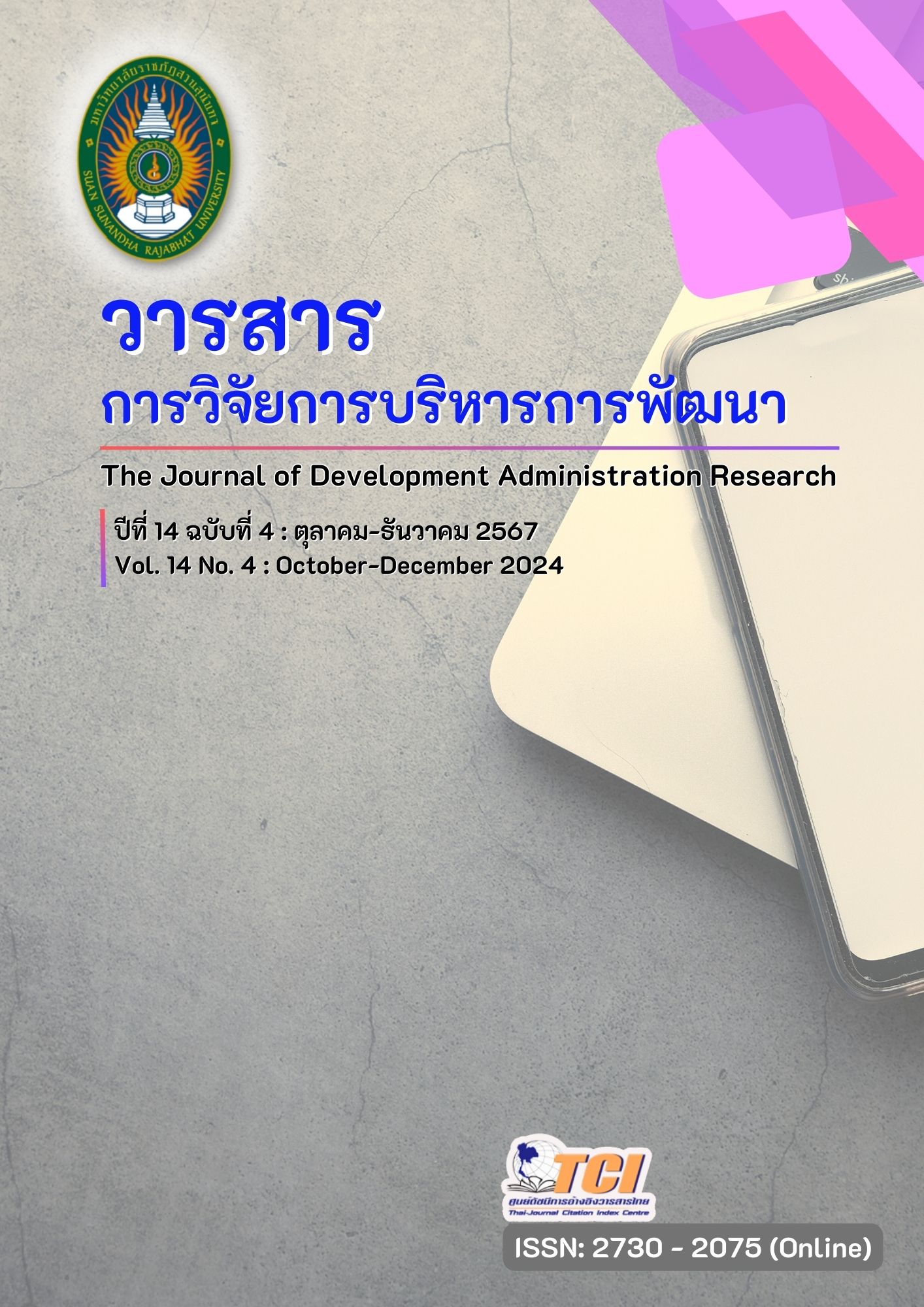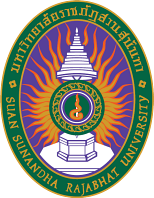การพัฒนาชุมชนเพื่อรองรับการท่องเที่ยวเชิงสุขภาพสำหรับนักท่องเที่ยวผู้สูงอายุ อำเภอเมือง จังหวัดเพชรบุรี
คำสำคัญ:
การพัฒนา, การท่องเที่ยวเชิงสุขภาพ, นักท่องเที่ยวผู้สูงอายุบทคัดย่อ
จากแนวโน้มพฤติกรรมนักท่องเที่ยวปัจจุบันให้ความสำคัญเรื่องสุขภาพ และจังหวัดเพชรบุรียังได้รับการจัดเป็นพื้นที่นำร่องเพื่อส่งเสริมการท่องเที่ยวเชิงสุขภาพ การวิจัยนี้จึงมีวัตถุประสงค์เพื่อ 1) ศึกษาศักยภาพการท่องเที่ยวเชิงสุขภาพของชุมชน 2) พัฒนารูปแบบกิจกรรมเพื่อส่งเสริมการท่องเที่ยวเชิงสุขภาพอย่างสร้างสรรค์ของผู้สูงอายุ เพื่อรองรับการท่องเที่ยวเชิงสุขภาพสำหรับนักท่องเที่ยวผู้สูงอายุในชุมชนย่านเมืองเก่าริมแม่น้ำเพชรบุรี โดยระเบียบวิธีวิจัยเชิงคุณภาพโดยการสำรวจ การสัมภาษณ์ และการประชุมกลุ่มย่อยจากผู้ที่มีส่วนเกี่ยวข้อง รวมถึงการสัมภาษณ์เชิงลึกกลุ่มนักท่องเที่ยวที่มาทดลองเส้นทาง ผลการวิจัยพบว่า 1) ศักยภาพการท่องเที่ยวเชิงสุขภาพของชุมชนย่านเมืองเก่าริมแม่น้ำเพชรบุรี มีความโดดเด่นด้านวิถีชีวิต ศิลปวัฒนธรรม
2) รูปแบบกิจกรรมเพื่อส่งเสริมการท่องเที่ยวเชิงสุขภาพอย่างสร้างสรรค์ของผู้สูงอายุกลุ่มคุณภาพตามหลักกิจกรรม 5 อ. โดยการประเมินและเสนอแนะแนวทางในการบริหารจัดการชุมชนต้นแบบพบว่า กลุ่มนักท่องเที่ยวส่วนใหญ่เป็นเพศหญิง มีอายุ 50 ปีขึ้นไป ระดับการศึกษาต่ำกว่ามัธยมศึกษาปลาย ภูมิลำเนาภาคกลาง มีอาชีพธุรกิจส่วนตัว/ค้าขาย รายได้เฉลี่ยต่ำกว่า 10,000 บาท/เดือน เคยเดินทางมามากกว่า 3 ครั้ง เพื่อพักผ่อนหย่อนใจ และสนใจกิจกรรมสร้างสรรค์เรียนรู้สิ่งใหม่ๆ นอกจากนี้รับรู้ข้อมูลมาจากเพื่อน/ครอบครัวและญาติ ส่วนการประเมินกิจกรรม 5 อ. อยู่ที่ระดับมากที่สุด งานวิจัยนี้มีความแตกต่างโดยได้ต้นแบบผลการประเมินการพัฒนาชุมชนซึ่งพบว่า ชุมชนเมืองเก่าเหมาะที่จะเป็นต้นแบบแหล่งท่องเที่ยวและกิจกรรมเชิงสุขภาพ เพื่อผู้สูงอายุ
เอกสารอ้างอิง
Chatchawanchanchanakij, P. (2021). Tourism Components Influencing Health Tourism Image of Ranong Province. Retrieved October 8, 2022, from https://libdoc.dpu.ac.th/thesis/ Petcharaporn.Cha.pdf
Chulalongkorn University Intellectual Property Institute. (2017). Report on Technology and Industry: Tourism Industry in High Income Group and Health Tourism. Retrieved October 8, 2022, from https://www.ipthailand.go.th/images/3534/web_01052018/Report_CHU/8_Wellbeing_06.12.2017_CHU.pdf
Cohen, E. (1979). A Phenomenology of Tourist Experience. Sociology, 13(2), 179-201.
Collier, A. & Harraway, S. (1997). Principle of Tourism. Auckland: Longman.
Department of Cultural Promotion. (2019). Value Culture to Value Adding. Retrieved October 15, 2022, from http://www. culture.go.th/culture_th/ewt_news .php ?nid=3972&filename=index
Department of Older Persons. (2019). Statistics of the elderly 2022. Retrieved September 15, 2022, from https://www.dop.go.th/th/know/side/ 1/1/1159
Dini, M. & Pencarelli, T. (2022). Wellness Tourism and the Components of its Offer System: a Holistic Perspective. Tourism Review, 77(2), 394–412.
Dongnadeng, H. A. (2020). The Needs for Health Care Among the Elderly in the Trang Municipality Area of Trang Province. Journal of humanities and social sciences Songkhla Rajabhat university, 2(1), 29–50.
Fancourt, D., et al. (2022). Psychological Benefits of Hobby Engagement in Older Age: a Longitudinal Cross-Country Analysis of 93,263 older adults in 16 countries. Research Square, 1-22. Retrieved September 10, 2022, from https://doi.org/10.21203/rs.3.rs-2349781/v1
Global Wellness Institute. (2018). Global Wellness Tourism Economy. Retrieved September 10, 2022, from https://globalwellness institute.org
Healthserv. (2022). 3 Trends of Wellness Tourism in 2022. Retrieved October 10, 2022, from
Hidalgo, J. L., Sotos, J. R. & DEP-EXERCISE Group. (2021). Effectiveness of Physical Exercise in Older Adults With Mild to Moderate Depression. Annals of family medicine, 19(4), 302–309.
Isichaikul, R. (2009). Research Project on Promotion of Tourism for the Elderly from Europe to Thailand. Bangkok. Thai Tourism Development Research Institute Research Fund Office.
Jedrusek-Golinska, A., et al. (2020). Recent Progress in the use of Functional Foods for Older Adults: A narrative review. Compr Rev Food Sci Food Saf, 19(2), 835– 856.
Juntaprom, P. (2022). Effects of Using Health Care Program for Elderly in Spreading of Coronavirus Disease 2019 (COVID-19) (Master’s Thesis). Mahasarakham University.
Kaewsrithong, J. (2012). The effect of using a Training Program on Artificial Arts for the Elderly in the Center for the Development of Social Welfare for the Elderly, Ban Bang Khae, Bangkok. RMUTP Research Journal Science & Technology, 6(1), 68-80.
Kantha-oo, C. (2017). Community based tourism: A case study of Baan Roon Fong, Roon Fong sub-disdistrict, Mueang. Phrae district, Phrae province (Master’s Thesis). Chulalongkorn University. Retrieved September 1, 2022, from http://cuir.car.chula.ac.th/handle/123456789/58300
Kasikorn Research Center. (2019). Thailand will Quickly enter an Aging Society in 2022. Business opportunities come with challenges. Retrieved September 1, 2022, from https://kasikorn research.com/th/analysis/k-econ/business/ Pages/z3053.aspx
Konu, H., Tuohino, A. & Björk, P. (2012). Wellbeing Tourism in Finland: Finland as a CompetitiveWellbeing Tourism Destination. Retrieved December 15, 2022, from https://erepo.uef.fi/bitstream/handle/12 3456789/10714/urn_isbn_978-952-61-0585-7.pdf
Kotler, P., Bowen, J.T. & Makens, J.C. (2006). Marketing for Hospitality and Tourism. (4th ed.). Upper Saddle River: Prentice-Hall.
Kumkong, M., Suwanaraj, M. & Saetiew, S. (2018). Food and Nutritional Management Model for Older Adults using the Mother’s Food Guideline: A Case Study of the Elderly Club, Boromarajonani College of Nursing Songkhla. The Southern College Network Journal of Nursing and Public Health, 5(3), 53-68.
Lee-Anant, C., (2022). Guidelines of Health Tourism Management for Elderly Tourists. Journal of Yala Rajabhat University, 17(1).147-155.
Marketeer. (2017). Wellness Tourism: The Opportunity of Tourism Business. Retrieved December 20, 2022, from https://marketeeronline.co/ archives/21776
Ministry of Public Health. (2017). 5 Healthy Habits for the Elderly to Maintain Good Health. Retrieved December 5, 2022, from https://multimedia.anamai.moph.go.th/help-knowledgs/elderly.
Ministry of Tourism and Sport. (2020). Annual report. Bangkok: Ministry of Tourism and Sport.
Pankong. O. & Sangournpak, O. (2012). Effects rum Thai Prayouk on Muscular Strength, Activity of Daily Living and Well-being of Older Persons. Nursing Journal CMU, 39(5), 118–127.
Raphael, R. (2020). 2020 Wellness Trends, Aging Rebranded: Positively Cool. Global Wellness Summit. Retrieved December 20, 2022, from https://www.globalwellnesssummit.com/2020-global-wellness-trends/
Rattanasiri, M. (2018). Nutrition for Elderly. Journal of Southern Technology, 11(2), 221-228.
Sangsawang, P., Jintanavat, R. & Sukumwang, K. (2016). Effect of square-Stepping exercise on physical fitness among Older persons. Thai Journal of Nursing Council, 31(1), 5-18.
Sawangbumrung, M. (2019). Loneliness and Travel Behaviors of Older People. The journal of Psychiatric Nursing and Mental Health, 33(1), 36-52.
Scheyvens, R. (1999). Ecotourism and the Empowerment of Local Communities. Tourism Management, 20, 245-249.
Seedapeng, A. & Tansenee, J. (2021). Study and Development of Health Tourism Management Guideline for Elderly of Maejo University. Kasalongkham Research Journal. Chiangmai Rajabhat University, 15(2), 137-154.
Silpakit O. (2008). Srithanya Stress Scale. Journal of Mental Health of Thailand, 16(3), 177-185.
Soonthonsma, V., & Thammachart, P. (2016). Community-Based Healthy Tourism Patterns for Sustainable Development of Community-Based Enterprise Networking in Prajinburi Province. Journal of the Association of Researchers, 21(3), 167-181.
Suwannachang, N. (2008). Tourist satisfaction with the cultural tourist attractions of the Koh Temple community Phetchaburi. Phetchaburi: Phetchaburi Rajabhat University.
Taweecheep, N., Manoban, A., & Onta, T., (2019). The Needs for Organizing Recreational Activities for Senior Citizens in Ban Lao sub-district, Ban fang district, Khonkaen Province. Journal of Education, Silpakorn University, 16(2), 213-222.
Thongwilai, B. (2016). Exploratory Factor Analysis of Travel Routes for Thai Tourist in Pranburi, Prachuab Khiri Khan Province (Master’s Thesis). Bangkok University. Retrieved October 10, 2022, from http://dspace. bu.ac.th/jspui/handle/123456789/2365
Tomioka, K., Kurumatani, N. & Hosoi, H. (2016). Relationship of Having Hobbies and a Purpose in Life With Mortality, Activities of Daily Living, and Instrumental Activities of Daily Living Among Community-Dwelling Elderly Adults. Journal of epidemiology, 26(7), 361–370.
Tourism Authority of Thailand. (2015). A Project to Study the Needs of Elderly Tourists to Prepare for Domestic Tourism. Bangkok: Tourism Authority of Thailand.
Tourism Authority of Thailand. (n.d.). 9 New Trends in the Future of Tourism. Retrieved October 5, 2022, from https://thai.tourismthailand. org/Articles/9tat
Utami, P. A. S. & Prapti, N. K. G., (2020). Recreational Activities and Travel Choices of the Elderly. Indonesian journal of global health research, 2(2), 165-174.
Wattanakamolchai, S. & Yimon, Y. (2013). Senior Tourists: A Market with Potential for the Tourism industry. Panyapiwat Journal, 2(1), 95–103.
World Travel & Tourism Council. (2019). Economic Impact Report. Retrieved October 20, 2022, from https://wttcweb.on.uat.co/
ดาวน์โหลด
เผยแพร่แล้ว
รูปแบบการอ้างอิง
ฉบับ
ประเภทบทความ
สัญญาอนุญาต
ลิขสิทธิ์ (c) 2024 วารสารการวิจัยการบริหารการพัฒนา

อนุญาตภายใต้เงื่อนไข Creative Commons Attribution-NonCommercial-NoDerivatives 4.0 International License.
บทความที่ได้รับการตีพิมพ์เป็นลิขสิทธิ์ของมหาวิทยาลัยราชภัฏสวนสุนันทา
ข้อความที่ปรากฏในบทความแต่ละเรื่องในวารสารวิชาการเล่มนี้เป็นความคิดเห็นส่วนตัวของผู้เขียนแต่ละท่านไม่เกี่ยวข้องกับมหาวิทยาลัยราชภัฏสวนสุนันทา และคณาจารย์ท่านอื่นๆ ในมหาวิทยาลัยฯ แต่อย่างใด ความรับผิดชอบองค์ประกอบทั้งหมดของบทความแต่ละเรื่องเป็นของผู้เขียนแต่ละท่าน หากมีความผิดพลาดใดๆ ผู้เขียนแต่ละท่านจะรับผิดชอบบทความของตนเองแต่ผู้เดียว




